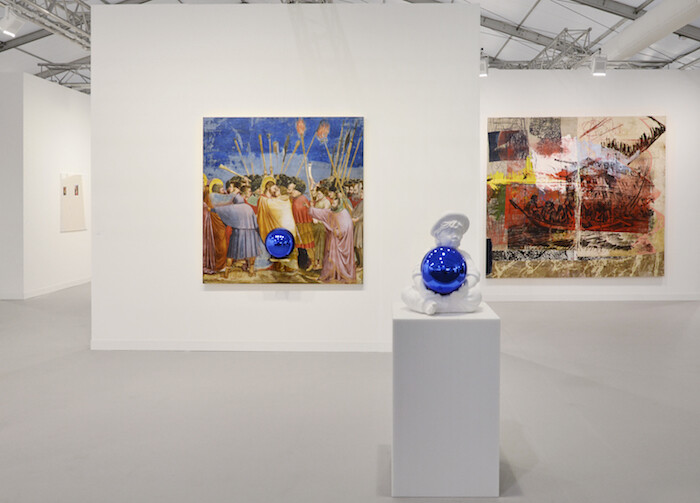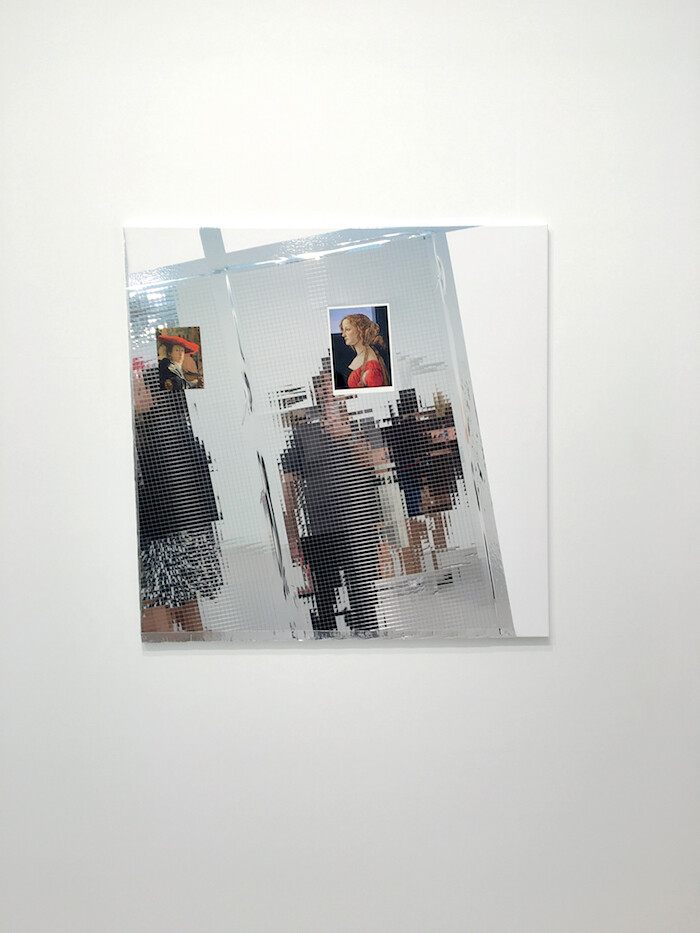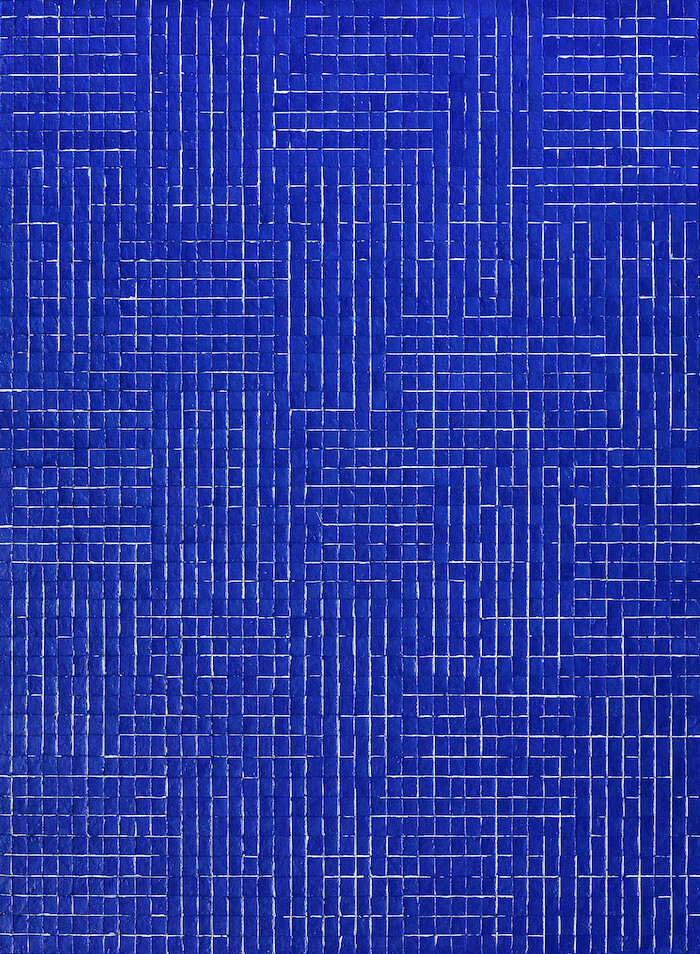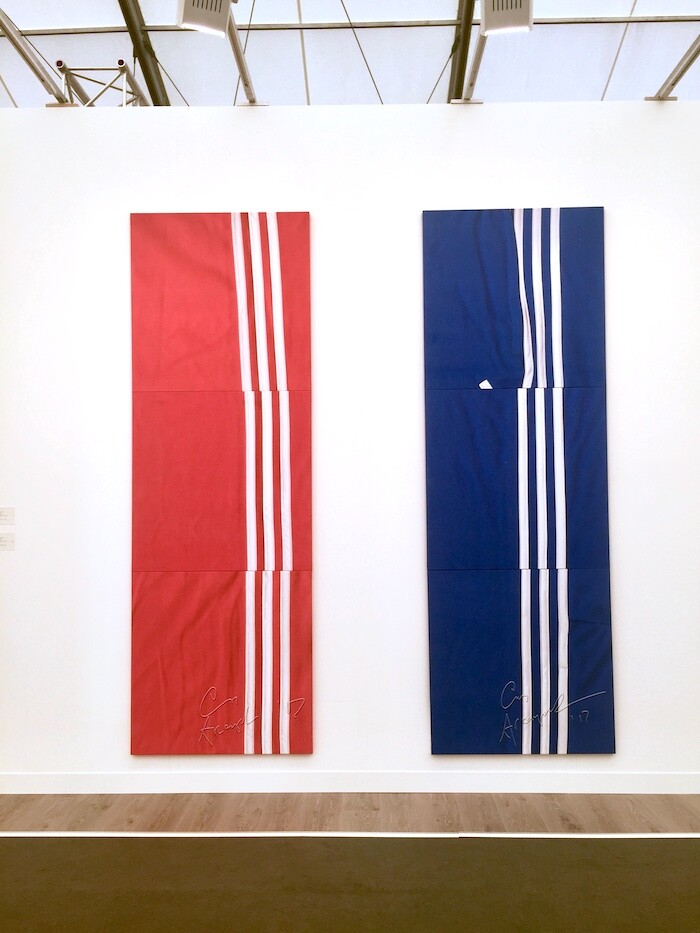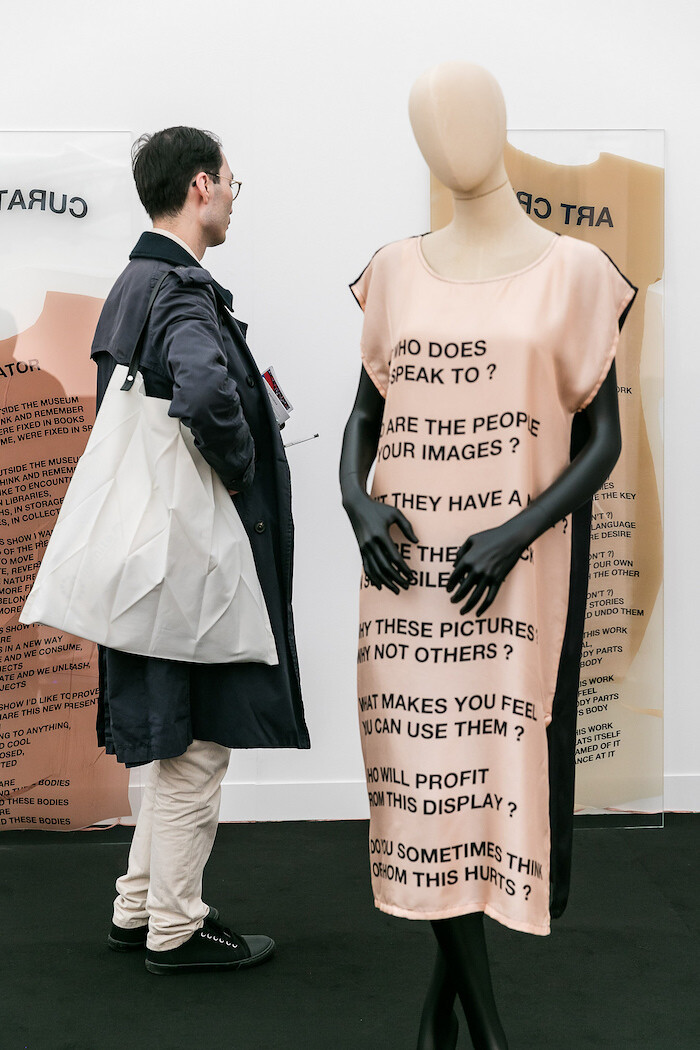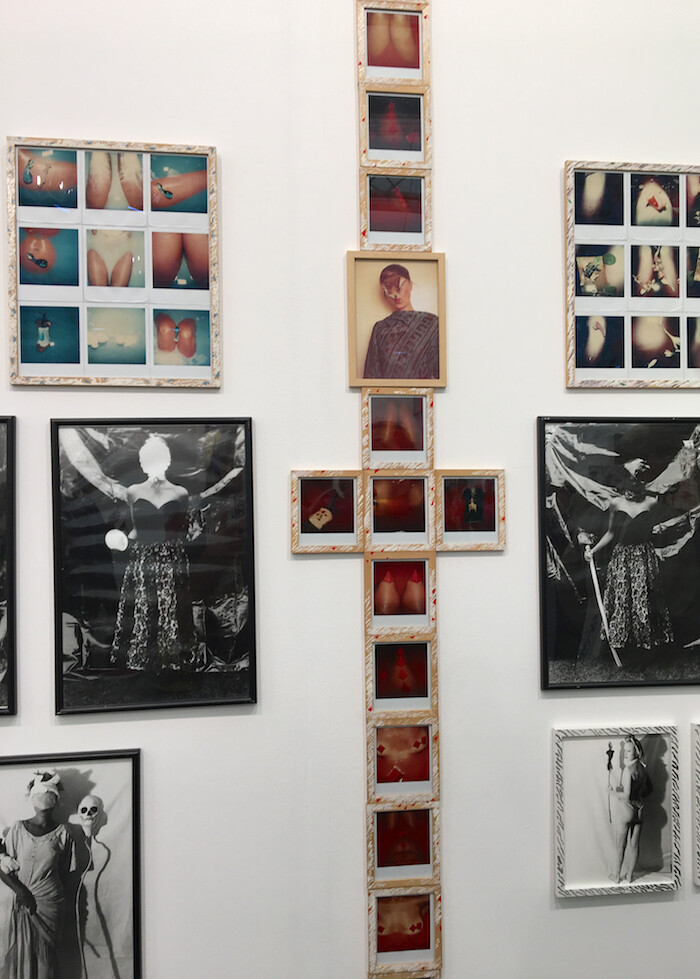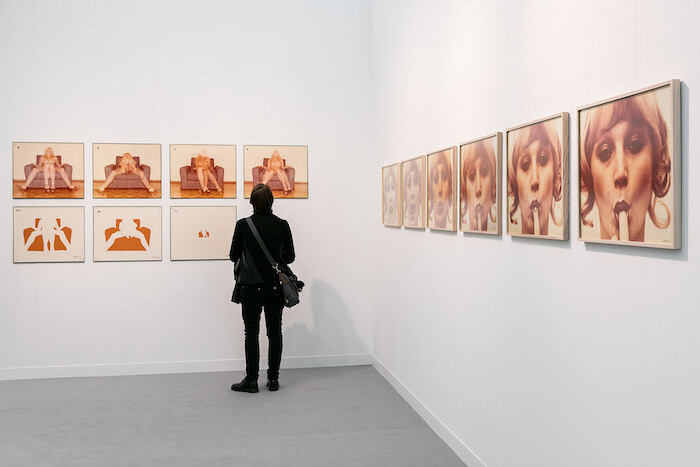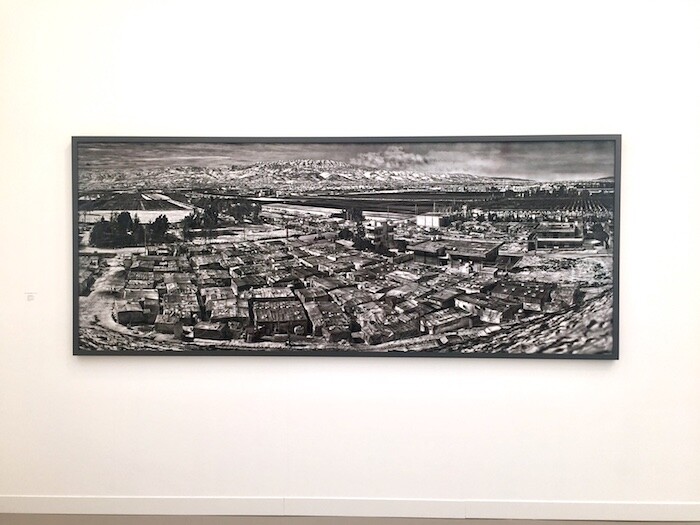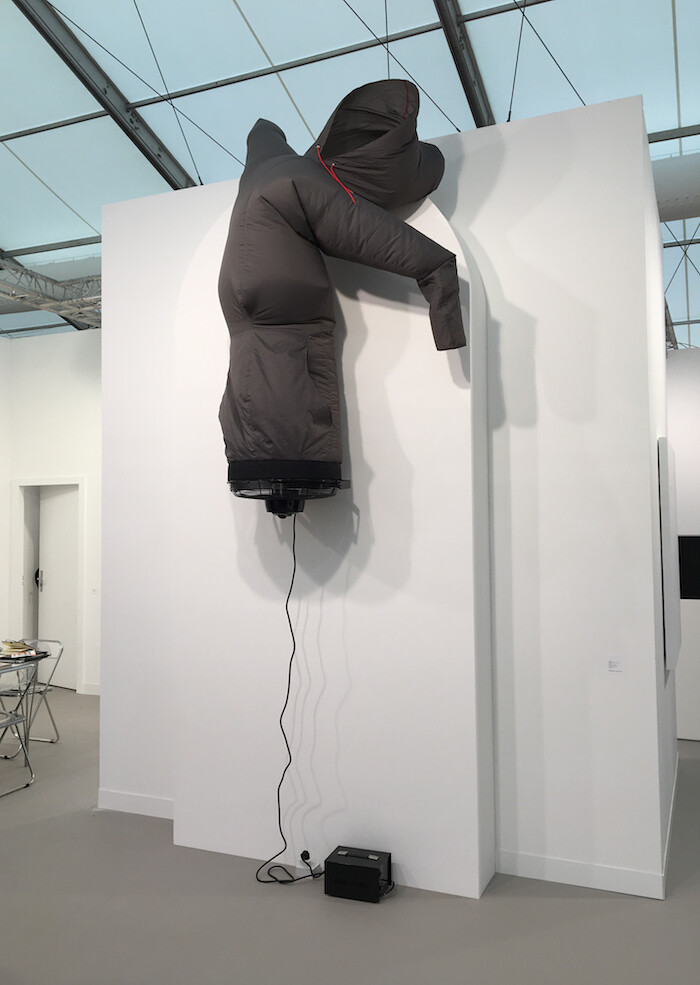October 4–8, 2017
Leave or Remain, Trump or Clinton, terror, peace, boredom, or indifference: no matter where the world is at culturally, politically, socially, or existentially, there will always be another Frieze fair in early October. If last year’s edition occurred within the shadow of a particularly pronounced period of political uncertainty, by now the cards have all been shuffled and we know where we’re at (or more likely, where we’re heading). But “art”—often thought of as a mirror of society at large—can feel particularly distorted in the art-fair setting: both figuratively, in terms of the forms and themes highlighted; and quite literally, as in any number of the inordinately large selection of selfie-ready mirror works that hang in wait. And selfie I did, in an untitled 2015 work by Isa Genzken at New York’s David Zwirner that provided a low-tech, analog method of pixelization.
Perhaps it’s not wise to expect this enormous commercial endeavor to do justice to the things that make art something that we want to look at, make, or participate in, something we think about incessantly. Maybe the art fair has as much to do with art as a wedding convention has to do with love. But as art is ostensibly the definitional subject of the event itself, which also contains an ambitiously curated program of exhibitions, performances, talks, films, and other projects, it becomes appropriate to attempt to engage with the art on terms that this setting dictates. Thus, I navigated the fair with camera phone in hand, snapping across the massive grounds and thinking about each work and artist’s value, their spectacle and potential future legacy with no more contextual information than what I entered with. This type of engagement can be rather foreign to certain art lovers like myself, who might find some cognitive dissonance in, for example, the Deutsche Bank Wealth Management Lounge presenting a closed showing of the work of John Akomfrah. But the setting necessitates that you take it as it comes.
This method of un-contextual viewing greatly favors works which prize the visual, from those of Korean painter Chung Sang-Hwa at Seoul’s Gallery Hyundai, whose minimal paintings, made across five decades, are virtually indistinguishable from each other, to Cory Arcangel’s supersized Adidas canvases (Three Stripes, 2017) at London’s Lisson Gallery. Other works which usually benefit from some conceptual heft are left hanging without a thread to tie them together. In the sterility of the art fair booth, Marcel Broodthaers’s work, shown at New York’s Marian Goodman Gallery, becomes a simple juxtaposition of polite objects, instead of an ensemble that weaves together aural, textual, sculptural, and extra-visual information into a spectral collage inside the viewer’s mind.
The few works with which I had a good experience not only engage the viewer visually and conceptually but also create their own context. Lili Reynaud-Dewar’s Small Tragic Opera of Things and Bodies in the Museum (2017) at Vienna’s Galerie Emanuel Layr consists of an installation that interrogates the archetypal definitions of artist, curator, critic, viewer, and so on. Each of these characters gets a first-person statement, distorted under glass, made into a wearable garment on a mannequin and spoken in electronic music heard through speakers. The texts can be understood as parodic, the curator saying “With this show I’d like to prove that we all share this new present, this condition. We don’t belong to anything, we’re fluid and cool, we’re all exposed, we’re confronted.” More than simply humorous, Reynaud-Dewar’s installation at least interrogates why we’re all here, something that the friends, colleagues, and acquaintances I met throughout the day for the most part couldn’t really answer.
Similarly, Birgit Jürgenssen’s 10 Days – 100 Photos (1980-81), shown at London’s Alison Jacques Gallery, creates its own setting through its impressive display of visually related self-portrait series, providing a subtle response to Viennese Actionism. The hundred photos, some in color and others black-and-white, are shot with different relations to the body and different objects, costuming, and visual motifs. Close-up views of the artist’s body covered in mud, leaves, or colored water twist flesh into near-abstraction, while several wider views incorporate Grand Guignol elements and improvised veils into erotically charged, ritualistic boudoir portraits. The images stack together to create a larger picture of an occult tenderness, a blurry line between warmth and abjection.
Jürgenssen’s work also appears in the highlight of the whole undertaking of the fair, the special section titled “Sex Work: Feminist Art & Radical Politics.” Curated by Alison Gingeras, it looks at the work of nine artists whose art and ideas didn’t fit in comfortably with themes and tropes of feminist art and thought during the 1960s, ‘70s, and beyond. The implicit extension of this proposition is that “Sex Work” aids in bringing these works more fully back into public view, though doing so through the commercial sale of the work isn’t necessarily the most satisfying proposition for audiences. But the micro-exhibition format provides an enticing teaser, and it begs the proposal that each artist should get a career-spanning survey such as Marilyn Minter’s (shown in “Sex Work” with Baldwin Gallery, Aspen; Regen Projects, Los Angeles; and Salon 94, New York) at the Brooklyn Museum last year. Still, the rare and welcome chance for audiences to discover Dorothy Iannone’s rainbow-colored porn/cartoon hybrids at Paris’s Air de Paris, Penny Slinger’s surreal photomontages at Los Angeles’s Blum & Poe, and Natalia LL’s captivating 16mm performance films from Warsaw’s lokal_30 seems the best gift the fair could provide, attesting to how far thoughtful curation can go in this environment.
The thorniest moments of the eight hours I spent inside the tent came while trying to parse the place of art that engages with the socio-political. What does it mean for a collector to spend thousands of pounds on a large black-and-white Richard Mosse photograph of a Syrian refugee camp in Lebanon (Tel Sarhoun Camp, Lebanon, 2017, shown at New York’s Jack Shainman Gallery)? Or on Paul Chan’s Pillowsophia (After Trinity) (2017) at Greene Naftali, New York, a goof on the fan-propelled nylon characters that flap outside of American car dealerships, but shaped into the now-iconic symbol of a black hoodie? In the distracted, oversaturated, and largely inconsiderate setting of the fair, Chan’s figure comes off as a cheap gag, when his past work surely indicates that there’s a lot more to it than that.
Presenting Mosses and Chans like items in a grocery store, or showing how they could be politely displayed in someone’s home, challenges one’s understanding of art as an object of social relations. And this is perhaps inevitably felt with works that inherently require accessing one’s own social dimensions to view them. Instead of seeing this as a merely alienating mode of display, perhaps the disillusionment of the art fair can be a reminder that these same considerations (of luxury, legacy, future value, and social function) are operating on different scales—from the large state-funded museum down to the DIY warehouse exhibition—at all times, and will be re-enacted again, again, and again every early fall in a tent in London’s Regents Park.
